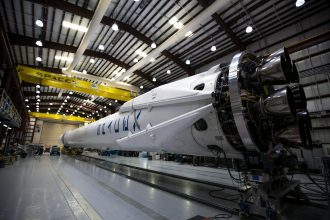# AI-Powered Inventory Management: Revolutionize Your Supply Chain
The modern supply chain is a complex, interconnected web, and managing inventory within it has always been a critical, yet often challenging, endeavor. Traditional methods, while once sufficient, are increasingly struggling to keep pace with the demands of today’s globalized and fast-moving markets. Enter the era of **AI-powered inventory management**, a transformative approach that promises unprecedented efficiency, accuracy, and foresight. This isn’t just an upgrade; it’s a fundamental shift in how businesses can optimize their stock, reduce waste, and gain a significant competitive edge.
## The Evolving Landscape of Inventory Management
For decades, businesses relied on manual counts, spreadsheets, and basic forecasting models. While these methods provided a baseline, they were prone to human error, slow to adapt to market fluctuations, and often resulted in either costly overstocking or damaging stockouts. The digital revolution brought about Enterprise Resource Planning (ERP) systems and Warehouse Management Systems (WMS), which offered significant improvements in data tracking and process automation. However, even these sophisticated systems often operated on historical data, lacking the predictive capabilities to truly anticipate future needs.
### The Limitations of Traditional Approaches
* **Human Error:** Manual data entry and physical counts are inherently susceptible to mistakes, leading to inaccurate inventory records.
* **Slow Reaction Times:** Market shifts, demand spikes, or supply chain disruptions can take time to be identified and addressed with traditional systems.
* **Inefficient Forecasting:** Reliance on historical data alone can miss emerging trends or unforeseen events.
* **High Carrying Costs:** Overstocking ties up capital, increases storage expenses, and heightens the risk of obsolescence.
* **Lost Sales:** Stockouts lead directly to lost revenue and diminished customer satisfaction.
## Unlocking Efficiency with AI-Powered Inventory Management
Artificial Intelligence (AI) is not just a buzzword; it’s a powerful engine driving innovation across industries, and supply chain management is no exception. AI-powered inventory management leverages machine learning algorithms, advanced analytics, and real-time data processing to create a dynamic, intelligent system.
### How AI Transforms Inventory Processes
At its core, AI-powered inventory management seeks to answer a fundamental question: “How much of what product do we need, where, and when?” AI tackles this by analyzing vast datasets that go far beyond simple sales history.
Here’s how it works:
1. **Predictive Demand Forecasting:** AI algorithms can analyze a multitude of factors, including historical sales data, seasonality, economic indicators, social media trends, weather patterns, competitor activities, and even news events, to predict future demand with remarkable accuracy. This allows businesses to move from reactive to proactive inventory planning.
2. **Real-Time Visibility and Tracking:** Integrating with IoT devices, sensors, and existing ERP/WMS systems, AI can provide an up-to-the-minute view of inventory levels across all locations. This eliminates blind spots and ensures that accurate data is always available.
3. **Automated Reordering and Optimization:** Based on predicted demand and current stock levels, AI systems can automatically trigger reorder points, suggest optimal order quantities, and even negotiate with suppliers for the best pricing and delivery schedules.
4. **Dynamic Stock Allocation:** AI can intelligently decide where to position inventory across a network of warehouses or distribution centers to minimize shipping times and costs while meeting predicted customer demand.
5. **Waste Reduction and Shelf-Life Management:** For perishable goods, AI can meticulously track expiry dates and optimize stock rotation (First-In, First-Out – FIFO) to minimize spoilage and waste.
6. **Anomaly Detection and Risk Mitigation:** AI can identify unusual patterns that might indicate theft, damage, or potential supply chain disruptions, allowing for swift intervention.
## The Benefits of Embracing AI in Your Stockroom
The implications of implementing AI-powered inventory management are far-reaching and directly impact a company’s bottom line and operational resilience.
### Key Advantages to Consider:
* **Reduced Costs:** By minimizing overstocking and preventing stockouts, businesses significantly cut down on carrying costs, storage expenses, and lost sales opportunities.
* **Increased Accuracy:** AI-driven automation and data analysis drastically reduce human error, leading to more reliable inventory records.
* **Enhanced Efficiency:** Streamlined reordering, optimized stock allocation, and automated processes free up valuable human resources to focus on more strategic tasks.
* **Improved Customer Satisfaction:** Meeting demand consistently and delivering products promptly leads to happier, more loyal customers.
* **Greater Agility:** The ability to anticipate changes and adapt quickly to market dynamics makes businesses more resilient in the face of disruptions.
* **Data-Driven Decision Making:** AI provides actionable insights, empowering managers to make informed strategic decisions about procurement, sales, and logistics.
## Beyond Inventory: The Synergy with Blockchain and AI
The press release regarding the “Certified Blockchain & Supply Chain Professional®” hints at a powerful convergence of technologies. While AI excels at data analysis and prediction, blockchain offers unparalleled security, transparency, and traceability.
### How AI and Blockchain Complement Each Other:
When combined, AI and blockchain create a robust ecosystem for supply chain management.
* **Enhanced Data Integrity:** Blockchain can serve as an immutable ledger, recording every transaction and movement of goods. AI can then analyze this highly secure and trustworthy data to generate even more accurate forecasts and insights.
* **Smart Contracts for Automation:** Blockchain-enabled smart contracts can automatically execute actions based on predefined conditions, such as releasing payments upon delivery verification. AI can help determine these conditions and optimize contract parameters.
* **End-to-End Transparency:** Both technologies contribute to a transparent supply chain. Blockchain provides an auditable trail, while AI can analyze this trail to identify inefficiencies or potential risks that might be hidden within the data.
* **Improved Traceability:** For industries requiring strict compliance or product authenticity (e.g., pharmaceuticals, luxury goods), the combination ensures that every item can be traced from its origin to the end consumer, with AI providing insights into the journey.
## Implementing AI-Powered Inventory Management: A Step-by-Step Approach
Adopting AI might seem daunting, but a phased approach can make the transition smooth and effective.
1. **Assess Your Current State:** Understand your existing inventory management processes, identify pain points, and define your specific goals.
2. **Define Your Data Strategy:** Determine what data you have, what data you need, and how you will collect and integrate it. Data quality is paramount for AI success.
3. **Choose the Right Technology:** Research and select AI-powered inventory management software or platforms that align with your business needs and budget. Consider solutions that offer integration capabilities with your existing systems.
4. **Start Small and Pilot:** Begin with a pilot program in a specific area or product line to test the system and gather feedback.
5. **Train Your Team:** Ensure your staff is trained on how to use the new AI tools and understand the benefits they bring.
6. **Iterate and Scale:** Continuously monitor performance, refine the AI models based on new data, and gradually scale the implementation across your entire operation.
## The Future is Intelligent and Transparent
The integration of AI into inventory management is not a distant dream; it’s a present reality that is rapidly reshaping how businesses operate. From optimizing stock levels to enhancing supply chain resilience, the benefits are undeniable. As technologies like blockchain mature and become more integrated, the synergy between AI and these foundational systems will unlock even greater potential for efficiency, transparency, and competitive advantage.
The Certified Blockchain & Supply Chain Professional® certification signifies a growing recognition of the need for expertise in these advanced areas. For businesses looking to thrive in the coming years, embracing AI-powered inventory management is no longer an option – it’s a necessity.
—
copyright 2025 thebossmind.com
Source 1: [https://www.mckinsey.com/capabilities/operations/our-insights/the-future-of-supply-chains-is-intelligent](https://www.mckinsey.com/capabilities/operations/our-insights/the-future-of-supply-chains-is-intelligent)
Source 2: [https://www.gartner.com/en/industries/technology/supply-chain/insights/inventory-management](https://www.gartner.com/en/industries/technology/supply-chain/insights/inventory-management)
Featured image provided by Pexels — photo by cottonbro studio




 **Source 2:** [https://www.gartner.com/en/industries/technology/semiconductors](https://www.gartner.com/en/industries/technology/semiconductors) ---](https://thebossmind.com/wp-content/uploads/1/2025/10/pexels-photo-3840447-150x150.jpeg)

![Nuclear Reactor Submarine Systems: Powering the Deep ## Nuclear Reactor Submarine Systems: Powering the Deep The silent giants of the ocean, ballistic missile submarines, represent the pinnacle of naval engineering and strategic deterrence. At their heart lies a complex and incredibly powerful system: the nuclear reactor. These underwater behemoths rely on these sophisticated powerhouses not just for propulsion, but for the sustained operation of all their critical systems, from life support to weapons deployment. A recent announcement highlighting advancements in **nuclear reactor** plant **systems** for these submarines, involving MCG Companies and its subsidiaries like JTS, Point Eight Power, and DVM Power + Control, signals a significant step forward in naval technology. This development raises fascinating questions about the future of underwater power, the intricate engineering involved, and the implications for national security. ### The Unseen Engine: Understanding Submarine Nuclear Reactors For the uninitiated, the concept of a nuclear reactor powering a submarine might seem like science fiction. However, it's a reality that has defined naval power projection for decades. Unlike conventional submarines that require frequent surfacing to recharge batteries or refuel, nuclear-powered vessels can remain submerged for months at a time. This remarkable endurance is thanks to the continuous and abundant energy generated by their onboard nuclear reactors. **How Do They Work?** At its core, a submarine's nuclear reactor functions similarly to those found in power plants, albeit on a much smaller and more robust scale. The process involves nuclear fission, where atoms of a heavy element, typically uranium, are split, releasing a tremendous amount of energy in the form of heat. This heat is then used to boil water, creating high-pressure steam. The steam, in turn, drives turbines connected to generators, producing electricity. This electricity powers everything on the submarine, including: * **Propulsion:** Turning the propeller shafts that move the submarine through the water. * **Life Support:** Generating oxygen, scrubbing carbon dioxide, and maintaining a habitable environment for the crew. * **Sensors and Sonar:** Powering the sophisticated equipment used for navigation and detection. * **Weapon Systems:** Ensuring the readiness and operational capability of ballistic missiles and other armaments. * **Internal Systems:** Running lights, communications, and all other onboard machinery. The key advantage of nuclear power for submarines is its immense energy density. A small amount of nuclear fuel can power a submarine for its entire operational life, eliminating the need for frequent refueling and allowing for extended submerged patrols. ### The Latest Advancements: A Glimpse into the Future The press release regarding MCG Companies' involvement in enhancing **nuclear reactor** plant **systems** for ballistic missile submarines points to a continuous drive for innovation in this critical sector. While specific details of the advancements are often classified, we can infer the general directions of progress. **Key Areas of Focus for Modernization:** * **Increased Efficiency and Power Output:** Newer reactor designs are likely to be more efficient, generating more power from less fuel, and potentially allowing for faster transit speeds or greater operational flexibility. * **Enhanced Safety Features:** Safety is paramount in any nuclear application, and submarine reactors are no exception. Continuous improvements focus on passive safety systems that rely on natural physical laws to prevent accidents, even in extreme circumstances. * **Reduced Size and Weight:** Miniaturization of components and systems can lead to smaller, more streamlined submarines, or allow for more space for other critical equipment and crew amenities. * **Improved Maintainability and Reliability:** Making systems easier to maintain and more reliable reduces downtime and ensures the submarine can perform its missions without interruption. * **Stealth and Signature Reduction:** Modern naval warfare emphasizes stealth. Advancements in reactor technology may also focus on reducing the acoustic and thermal signatures of the submarine, making it even harder to detect. The involvement of companies like JTS, Point Eight Power, and DVM Power + Control suggests a comprehensive approach. JTS might be involved in the core reactor design and fuel handling, Point Eight Power could be contributing to the power generation and distribution systems, and DVM Power + Control might be focusing on the intricate control and automation aspects of the **nuclear reactor** plant **systems**. ### The Strategic Significance of Nuclear Submarine Power The ability to operate undetected for extended periods underwater is a cornerstone of modern strategic deterrence. Ballistic missile submarines, often referred to as "boomers," carry nuclear-armed missiles, providing a second-strike capability that is crucial for maintaining global stability. **Why is this so important?** 1. **Deterrence:** The survivability of nuclear submarines makes them a credible deterrent. An adversary knows that even after a first strike, these submarines can retaliate, making a pre-emptive nuclear attack an unacceptable risk. 2. **Stealth and Survivability:** Their ability to remain hidden beneath the waves ensures their survival, making them the most survivable leg of the nuclear triad. 3. **Global Reach:** Nuclear submarines can operate anywhere in the world's oceans, projecting power and providing intelligence gathering capabilities far from home shores. 4. **Continuous Presence:** Unlike aircraft or land-based missiles, submarines offer a persistent and unseen presence, providing a constant, albeit silent, message of capability. The ongoing development and modernization of **nuclear reactor** plant **systems** are therefore not just about technological advancement; they are about maintaining and enhancing a nation's strategic posture and ensuring its security in a complex geopolitical landscape. ### The Engineering Marvel: A Look Beneath the Surface Designing and operating a nuclear reactor aboard a submarine is an undertaking of immense complexity and requires an unparalleled level of engineering expertise. The environment in which these reactors operate is extreme – high pressure, limited space, and the constant need for absolute reliability. **Key Engineering Challenges:** * **Space Constraints:** Submarines are inherently confined spaces. Reactor components must be designed to be as compact and lightweight as possible without compromising safety or performance. * **Heat Dissipation:** Nuclear reactors generate significant heat. Efficiently dissipating this heat into the surrounding ocean water, while maintaining operational temperatures, is a critical design challenge. * **Vibration and Shock:** Submarines are subjected to constant vibrations from their own machinery and potential shockwaves from nearby underwater explosions. Reactor systems must be robust enough to withstand these forces. * **Radiation Shielding:** Protecting the crew and sensitive electronic equipment from harmful radiation is paramount. Extensive shielding is integrated into the reactor design. * **Crew Training and Expertise:** Operating and maintaining a nuclear reactor requires highly trained and dedicated personnel. Rigorous training programs are essential for ensuring the safety and effectiveness of these systems. The companies involved in the recent announcement are likely contributing specialized expertise to tackle these multifaceted challenges. For instance, a company specializing in power control systems would need to develop highly redundant and fail-safe mechanisms to manage the reactor's output, even under the most demanding operational conditions. ### Beyond Propulsion: The Holistic Role of Reactor Systems It's crucial to understand that the **nuclear reactor** plant **systems** aboard a submarine are not solely for propulsion. They form the lifeblood of the entire vessel, enabling its sustained operation in an environment where external power sources are non-existent. **The Interconnectedness of Systems:** Imagine a submarine at periscope depth, conducting surveillance. The reactor is not only powering the propulsion to maintain its position but also: * **Powering the sonar arrays** to listen for distant vessels. * **Operating the periscopes and optical sensors** for visual observation. * **Maintaining the atmospheric controls** to keep the air breathable for the crew. * **Running the communication systems** to relay intelligence back to command. * **Ensuring the readiness of the missile launch systems**, should the need arise. This demonstrates the intricate interdependence of all systems, all drawing power from the central nuclear reactor. Any disruption or inefficiency in the reactor system can have cascading effects throughout the submarine's capabilities. Therefore, advancements in this area are not just about raw power but about the reliability, efficiency, and integrated functionality of the entire platform. ### The Future of Submarine Power The continued investment in and development of **nuclear reactor** plant **systems** for submarines underscore their enduring strategic importance. As naval technology evolves, we can anticipate further innovations: * **Advanced Reactor Designs:** Exploration of smaller, more modular, and potentially even more efficient reactor types. * **AI and Automation:** Increased integration of artificial intelligence and advanced automation for monitoring, control, and predictive maintenance of reactor systems. * **Longer Deployment Cycles:** Continued efforts to extend the time between refueling, allowing for even longer submerged patrols and reduced operational costs. * **Enhanced Survivability Features:** Integrating new technologies to further improve the stealth and resilience of these platforms. The press release from MCG Companies offers a tangible sign that this evolution is already underway. It highlights the ongoing commitment to maintaining a technological edge in a domain where silent, enduring power is paramount. The silent, deep-running world of ballistic missile submarines is powered by a marvel of engineering: the nuclear reactor. As nations continue to invest in these critical assets, advancements in **nuclear reactor** plant **systems**, like those being pursued by MCG Companies, will be crucial for maintaining strategic advantage and ensuring global security. The intricate interplay of physics, engineering, and operational requirements makes these underwater powerhouses a testament to human ingenuity and a vital component of modern defense. copyright 2025 thebossmind.com Source: [Link to a reputable source discussing naval nuclear propulsion or submarine technology - e.g., a government defense agency website or a well-known defense industry publication.] Source: [Link to another reputable source, perhaps focusing on the specific companies mentioned or general advancements in nuclear engineering.]](https://thebossmind.com/wp-content/uploads/1/2025/10/pexels-photo-19870007-330x220.jpeg)



